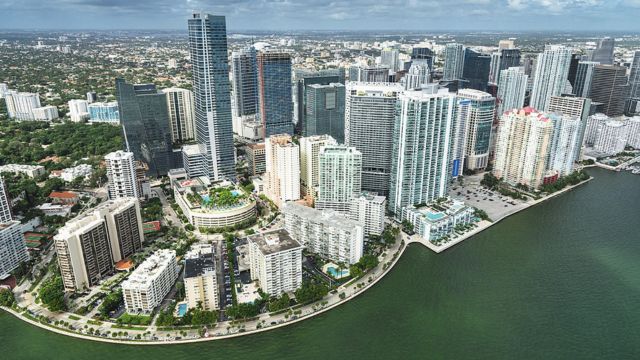Miami-Dade County, located in southeastern Florida, is home to approximately 2.7 million residents as of 2020, making it the most populous county in Florida and the seventh-most populous county in the entire United States.
Renowned for its diverse culture, thriving economy, and stunning beaches, the county attracts numerous visitors and residents alike. Nonetheless, it’s essential to acknowledge that there are certain areas within Miami-Dade County that experience higher crime rates and violence compared to others.
According to CrimeGrade.org, a website that assesses neighborhood livability and crime rates, the five most dangerous neighborhoods in Miami-Dade County are
5. Downtown
Downtown, situated in the central part of Miami, is surrounded by Biscayne Bay to the east, Interstate 95 to the west, Northeast 17th Street to the north, and South 15th Road to the south.
Its population stands at approximately 92,000 people, with a median household income of $43,000. As the financial, commercial, and cultural hub of Miami, Downtown boasts numerous skyscrapers, offices, shops, museums, and entertainment venues.
However, it’s important to note that Downtown also faces some challenges in terms of safety. The neighborhood’s crime rate is 10.45 per 1,000 residents, which is 40% higher than the Miami-Dade County average and 93% higher than the national average.
Specifically, the violent crime rate in Downtown is 2.53 per 1,000 residents, surpassing both the county and national averages. Common crimes in the area include robbery, assault, burglary, and theft.
Also Read:
4. Opa-Locka
Opa-Locka is a city located in the northern part of Miami-Dade County. Its boundaries are Northwest 151st Street to the north, Northwest 27th Avenue to the west, Northwest 119th Street to the south, and Northwest 17th Avenue to the east.
The population of Opa-Locka is around 16,000 people, and the median household income is approximately $21,000. One of the city’s notable features is its architectural style, which draws inspiration from the tales of One Thousand and One Nights, resulting in a unique Moorish-style architecture.
However, Opa-Locka also faces challenges in terms of crime rates. The city’s overall crime rate stands at 11.59 incidents per 1,000 residents, which is 51% higher than the average for Miami-Dade County and 105% higher than the national average.
Specifically, the violent crime rate in Opa-Locka is 3.01 per 1,000 residents, exceeding both the county and national averages. Common types of crimes reported in the area include robbery, assault, burglary, and theft.
Also Read:
3. Model City
Model City, located in the northwest part of Miami, is bordered by Northwest 79th Street to the north, Northwest 7th Avenue to the west, Northwest 54th Street to the south, and Interstate 95 to the east.
With a population of approximately 25,000 people and a median household income of $25,000, it stands as one of Miami’s oldest predominantly African-American neighborhoods, rich in historical landmarks and cultural institutions.
However, Model City faces challenges in terms of crime. The neighborhood has a crime rate of 12.73 per 1,000 residents, surpassing the Miami-Dade County average by 62%, and going 117% higher than the national average.
The violent crime rate is also above both county and national averages, standing at 3.49 per 1,000 residents. Common crimes in the area include robbery, assault, burglary, and theft.
Also Read:
2. Wynwood
Wynwood, situated in the north-central part of Miami, is bordered by Northwest 36th Street to the north, Interstate 95 to the west, Northwest 20th Street to the south, and North Miami Avenue to the east.
The neighborhood is home to approximately 20,000 residents, with a median household income of $29,000. Known for its vibrant and artistic atmosphere, Wynwood boasts numerous galleries, studios, captivating murals, and lively festivals.
However, it is essential to note that Wynwood has a relatively higher crime rate compared to Miami-Dade County and national averages. The neighborhood’s crime rate stands at 13.87 incidents per 1,000 residents, which is 73% above the county average and 129% higher than the national average.
Specifically, the violent crime rate in Wynwood is 3.97 per 1,000 residents, also exceeding the averages for both the county and the entire country. Common crimes in Wynwood include robbery, assault, burglary, and theft.
Also Read:
1. Overtown
Overtown, located in the northwest part of Miami, is surrounded by Northwest 20th Street to the north, Interstate 95 to the west, Northwest 5th Street to the south, and North Miami Avenue to the east.
This vibrant neighborhood is home to approximately 10,000 residents, with a median household income of $19,000. It holds a significant historical value as one of Miami’s oldest African-American communities, enriched with a diverse musical and cultural heritage.
However, Overtown also faces challenges with its crime rate. With 14.66 incidents per 1,000 residents, it surpasses the Miami-Dade County average by 80% and the national average by 136%.
Specifically, the violent crime rate in Overtown stands at 4.04 per 1,000 residents, which is higher compared to both the county and national averages. The neighborhood experiences various crimes, including robbery, assault, burglary, and theft.
Also Read:
Conclusion
Here are the 5 Most Dangerous Neighborhoods in Miami-Dade County, Florida, as per CrimeGrade.org’s data. Nevertheless, it’s essential to remember that crime statistics can fluctuate based on various factors, including the data source, collection method, and timeframe.
As a result, these rankings should be viewed as relative and indicative rather than absolute or definitive. Additionally, it’s crucial to acknowledge that the quality of life and desirability of a neighborhood isn’t solely determined by crime rates.
Other elements such as education, health, economy, environment, and cultural amenities also play a significant role in the well-being and happiness of the residents.












Leave a Reply